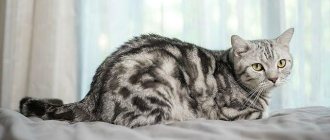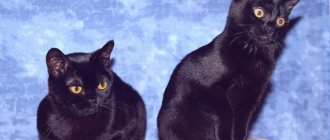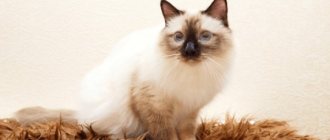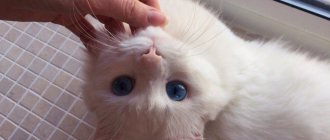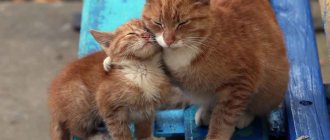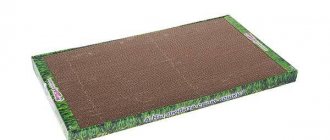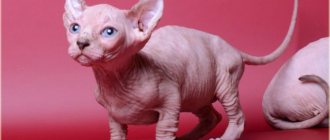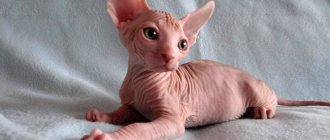Despite the fact that cats are very clean animals, their fur requires additional care from humans. Pets spend 3-4 hours every day licking their fur coat, but still they cannot always completely remove all dirt.
Grooming begins with proper and balanced nutrition. The animal must receive all the microelements and vitamins in order for its coat to be shiny. But regular grooming, which consists of a number of procedures, is no less important. In this article we will tell you how to care for cat fur depending on its length and thickness.
How to care for long-haired cats
Such cats have an “airy” appearance. There is a lot of air between the long hairs, making the coat look voluminous. But pets “pay” for this beauty with such a nuisance as tangles.
Due to the fact that there is a lot of space between the hairs, they are easily mixed and tangled. Therefore, the main care for cats of long-haired breeds is aimed at untangling and preventing tangles.
Your pet needs to be brushed daily for 15-20 minutes. If you neglect this procedure, the cat will not only become covered in tangles, but will also eat too much fur. The fact is that when animals lick themselves, they swallow hairs. Six accumulates in the stomach, which causes lack of appetite and vomiting.
To brush a long-haired cat, you need the following tools:
- sparse comb;
- fine comb;
- brush-mitten;
- scissors.
First, use a mitten to stroke the fur against the direction of growth to collect dead hairs. Then you should go with a sparse comb in the direction of hair growth. It is important to pay special attention to the area behind the ears and panties. If a tangle is found, it should be disassembled. If unsuccessful, the lump must be cut off. Then you need to go through it again with a fine-toothed comb to smooth the coat and make it more shiny.
To make the tangles easier to untangle, you can use special products. You can also use a spray to remove static electricity about every 5-10 combings. With it, the fur will become smoother and more beautiful and will be less tangled.
Important: due to the long fur, many skin diseases are diagnosed in an advanced state. During grooming, carefully examine the skin for abrasions, peeling, spots, and parasites. If you notice something is wrong, take your pet to the vet.
During the molting period, it is better to comb the animal twice a day. This will remove dead hairs and help new ones grow faster.
Danger of tangles
A mat is a sticky lump of dead hair that is held together by new regrown hairs. A large mat looks like felt. Due to tangles, new wool grows worse and its quality decreases.
What else are dangerous about tangles:
- ventilation of the skin deteriorates,
- when a cat tries to comb a mat with its paw, the skin may be injured,
- under the mat the blood circulation of the skin is impaired,
- there is a risk of inflammation of the skin under the lump.
How and with what to remove the mat:
- If the lump is still small and not very stuck together, then you can try to untangle it with your hands. Before you begin, dampen the tangle with tangle spray.
- Loose mats can be combed out with a wide-toothed comb.
- For large tangles that cannot be untangled with your hands and combed through, use scissors or a special tangle cutter.
- After procedures to remove the mat, inspect the skin that was underneath it. Make sure your skin is dry and free of inflammation. If inflammation begins, contact your veterinarian.
To prevent the formation of dense and large ridges, regularly examine your cat and care for your pet's fur.
Grooming long-haired cats
Long-haired breeds sometimes need a haircut:
- when a lot of tangles have formed in the wool;
- if the fur coat has lost its attractive appearance;
- if your pet does not tolerate heat well.
You should not cut your cat's hair unless absolutely necessary. And you definitely can’t do it yourself. Grooming cats takes skill and practice. An untrained person can easily ruin a luxurious fur coat. And if they start laughing at the animal, he will be offended - cats are great at reading emotions.
If your pet needs a haircut, it is better to contact our salon for this service. In the hands of professionals, your pet’s fur coat will take on a new, but certainly neat look.
Proper nutrition
The appearance and well-being of a cat largely depend on nutrition. If the diet is unbalanced, then this usually affects the quality of the coat: it becomes dry, loses its shine and elasticity, and hair begins to split and fall out. To avoid this, choose a complete ready-made food for your cat - it already contains all the necessary nutrients, vitamins, and minerals. Long-haired cats may also need a product to help remove hair from the gastrointestinal tract. A veterinarian will help you decide on the choice of diet and supplements, taking into account the cat’s breed, age, activity, and health status.
Remember that the animal’s diet should not include food from your table. If you want to cook for your pet yourself, study in advance the daily intake of calories, fats, proteins, carbohydrates, vitamins, micro- and macroelements that the cat should receive, and pay attention to prohibited foods. Among them are fish, poultry and meat bones, sweets, herbs, avocados, smoked meats, etc. For smooth coat and healthy skin, it is important to choose foods rich in B vitamins (beef liver, meat, dairy products, etc.), vitamin A ( egg yolks, sea fish liver, etc.), omega-3 and omega-6 fatty acids (salmon, eggs, etc.).
Bathing a long-haired cat
Long-haired cats should be bathed more often than short-haired breeds. The water procedure can be carried out once a month or two. If the cat is clean, then even less often. Cats that walk outside require frequent washing. If the animal gets dirty, it should also be washed.
Before bathing, the cat should be brushed. You can pour water (37-38°C) into the bathtub, basin or sink. Don't forget to prepare two towels. One to remove water, the second to dry the wool. You should wash your pet carefully so that water does not get into the nose and ears. For washing you need to use shampoo for long-haired breeds. Never use human shampoo. It has a completely different Ph, which can ruin the skin.
After bathing, the cat can be dried with a hairdryer (if it is not afraid) with a brush. If your pet cannot tolerate a hair dryer, let its coat dry a little and comb it carefully.
You can also use special sprays and dry shampoos for express cleaning. They effectively wash away dirt without washing, nourish the fur and prevent it from matting.
Healthy coat and skin
The first step to brushing your cat is to check its fur. Healthy wool has natural elasticity and a slight shine. Any receding hairline, unusual bumps, patches of dead hair, or signs of ticks or fleas are cause for concern.
Both long-haired and short-haired cats need grooming. However, each coat style requires different brushes and brushing techniques to achieve the best results.
Features of caring for short-haired breeds
Owners of cats with short hair are luckier. Their pets require simpler care. These animals do an excellent job of licking, and tangles do not form in their fur. But, nevertheless, short-haired cats also need grooming.
Care consists of brushing approximately twice a week. For this you need:
- brush mitten;
- comb with fine teeth;
- brush with natural bristles.
First, use a soft mitten. Then comb the animal with a comb. Finally, go over with a brush to give the coat a shine. Periodically, the animal can be stroked with wet hands to remove loose hairs.
Dry cleaning
For cats with short, dark fur, dry brushing is a suitable replacement for bathing, unless the fur is very dirty. A bran “bath” is usually used. Place 0.45 - 0.9 kg of bran in the oven and heat to such a temperature that your hand is hot. Lay a newspaper on the kitchen table and place the cat on it. Using both hands, rub the heated bran into the wool.
Most cats enjoy this treatment: they enjoy the heated bran and purr continuously. After processing all the fur, transfer the cat to a clean sheet of newspaper and start combing out the bran. After all these manipulations, the fur coat will really shine. For long-haired cats, a bran bath is not recommended: uncombed bran particles often lead to the formation of painful tangles.
Washing short-haired cats
This breed should be washed approximately 1-2 times a year. If the animal is dirty or has parasites in its fur, bathing is mandatory. Cats that walk outside can be washed a little more often, up to 4 times a year. Don't get too carried away with water treatments. If the animal is clean, its coat will be in good condition.
Breeding work with Highland Straights
Strict breeding rules prohibit the breeding of two Scottish Fold cats. The parent pair always consists of a straight and a fold, therefore, in one litter of Scottish cats, both straights and folds are necessarily born. There is an unprofessional opinion that the Scots are still infused with the blood of the British breed - but this is nothing more than a myth.
Nuances of breeding
Folds should absolutely not be bred with folds, because as a result genetic abnormalities occur that are fraught with serious problems with the musculoskeletal system and pathologies of internal organs. Mixed pairs “fold+straight” are the only competent way of intrabreeding work.
Castration or sterilization of Highland Straights is done both for medical reasons and at the request of the breeder, who wants to receive confirmation that the animal will not be used for breeding. Surgery is usually performed on male and female cats after eight months of age.
There will definitely be both folds and straights in one litter
It will probably be possible to judge which of the kittens in the litter have straight ears and which have floppy ears only when the babies reach a month or at least three weeks of age. All newborn kittens have straight ears, and remain so for some time.
Caring for snow-white cats
White fur is more difficult to care for. If you neglect it, the fur coat will become yellow and dirty.
Due to the lack of pigment, the hair of white cats is hollow. Because of this, after each wash you need to use a balm or conditioner. During bathing, whitening shampoos for white cats should be applied. It is advisable to leave the detergent for a couple of minutes so that it works better.
In addition to washing, preventing contamination is also important. Clean the house regularly, avoiding areas under the sofa, mezzanine, etc., where the animal can climb. Also teach your pet not to climb where he can get dirty.
The frequency of brushing white cats depends on the thickness and length of the coat. Here the grooming is the same as for long-haired or short-haired breeds.
Comfortable microclimate
If apartment owners love warmth, it is worth considering whether constantly high air temperatures are harmful to the health of their pets. Of course, there is no need to sacrifice your comfort and health and spend the winter wrapped in blankets. It is much more reasonable to use a system of compromises:
- ventilate the room more often;
- move the cat to the coolest room (rearrange its food bowls, toys and resting place there);
- turn on the air conditioning system in the apartment;
- If the air is too dry, turn on the humidifier.
History of exotics
The first representatives of cats, similar to today's Exotic Shorthair, appeared as a result of a not entirely successful experiment to improve the American Shorthair breed in the 50s of the last century.
These teddy bear-like cats were the result of an experiment gone wrong.
It seemed to breeders that to expand the colors and make the bones a little heavier, they could cross American Shorthair and Persian cats. As a result, kittens were born that were completely different from the original breed, but at the same time incredibly charming. Although the result was unexpected, it was decided to continue working on breeding these cute cats.
The Persian cat was taken to improve the qualities of the American Shorthair
Crossbreeding work was carried out without permission from the CFA Board of Directors, and the resulting kittens were very different in appearance from the standards of the American Shorthair cat. In 1966, Jane Martink, on behalf of breeders, made a proposal to separate hybrid kittens into a separate breed.
The American Shorthair was directly involved in the emergence of the new breed
This is how a new breed of exotic shorthair cats appeared with beauty standards that almost completely repeated the standards of the Persian cat, with the exception of plush wool.
In 1973, the standards for exotic shorthair cats moved closer to the Persians; the combination “with a stop” was added, meaning a rather sharp transition from the forehead to the nose. At this time, crossing Persians with any short-haired breeds was still allowed, but already in 1975 crossing became possible exclusively with Persians and the American Shorthair cat, and since 1980 - only with the Persian breed. Since 1990, the standards have established absolutely identical requirements for Persians and exotics; the only difference between these two breeds is wool. Soon the exotic breed was prohibited from crossing with any other breeds, including the Persian.
Exotics differ from Persians only in their fur.
Today, exotic litters can produce both short-haired and long-haired kittens. In the CFA (American Cat Fanciers' Association), exotics with long hair are considered a by-product and can take part in competitions where only placings are played, without assigning titles. In all other felinological organizations they are classified as Persian or exotic longhaired cats without any restrictions on participation in competitions. Crossbreeding between longhaired and shorthaired exotic cats is permitted everywhere except the CFA.

